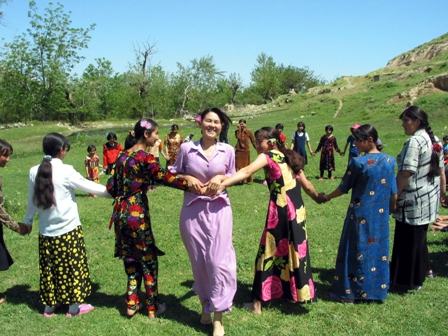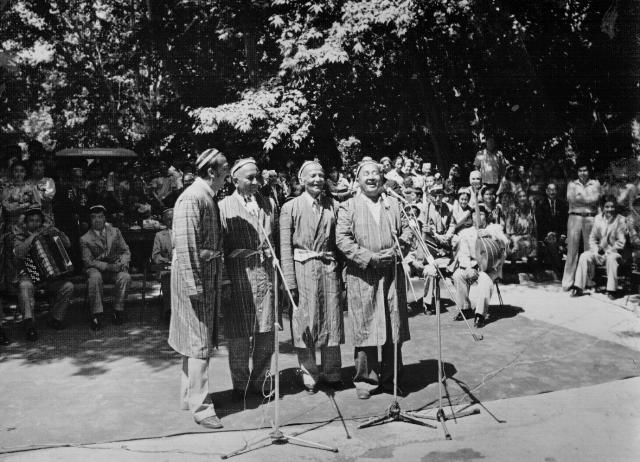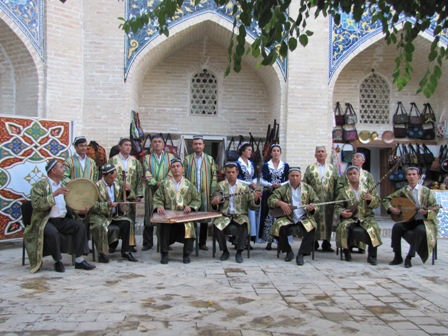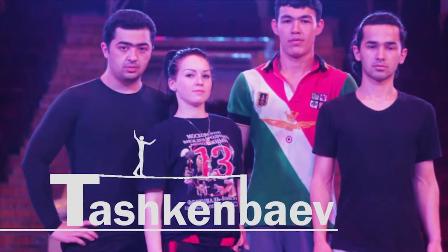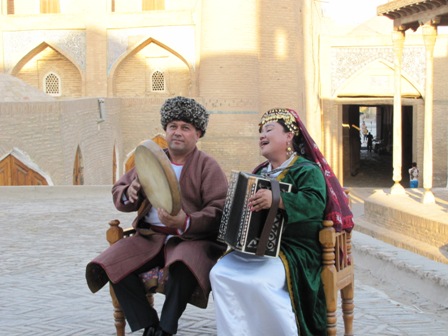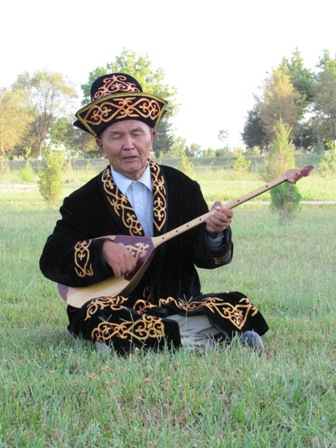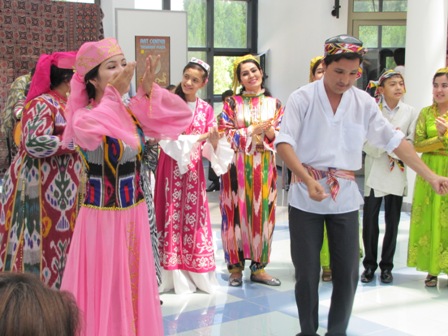BAKHSHICHILIK (BAKHSHI ART)
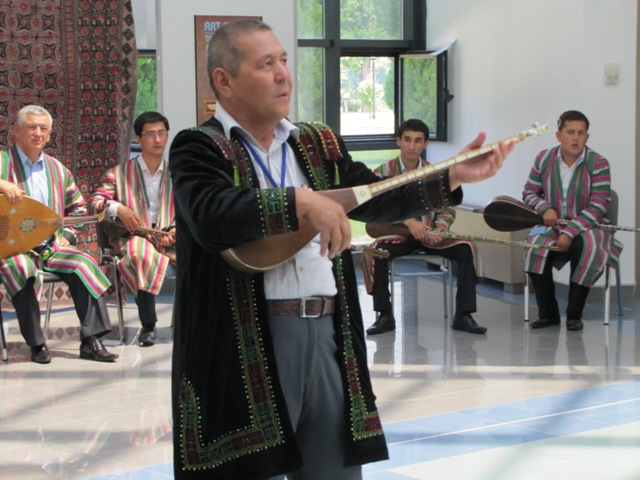
Domain: Performing Arts
Index Number: 02.02
Folk epic represents a cultural wealth of Uzbek peoples. As such, its importance cannot be underestimated. Looking at the history it is possible to notice that epic traditions emerged among the people of Uzbekistan (Uzbeks and Karakalpaks) in the ancient past. Since then, they have always existed and evolved.
Epic, in general, is alive because it exists in musical and poetical life. This occurs thanks to the creativity of bakhshi-shoirs (dostonchi, jyrau, baksy, yuzboshi, sannovchi), i.e. folk narrators, creators and keepers of epic traditions, popularizers of dostons, who represent in a single person a story-teller, poet, musician and actor. These are they, who transmit dostons, the greatest works of the people.
Bakhshi is a master and improvisator of words and stories, a skillful musician (skillfully plays on certain musical instrument) and singer (possesses the skills of traditional singing), who can accompany his performance with mimicry and plastique. He should be familiar with the life of his nation, with its culture and history. Moreover, he should have a rich vocabulary and masterly use popular language, be able to play with words, use their diverse forms. And all these features are connected with the art of bakhshi (bakhshichilik), which has centuries-long history.
Main requirements for the performers of dostons are: to provoke listener's interest with own melodies; to narrate a story (i.e. an epic) in an interesting and attractive manner. These, in turn, require that bakhshi-shoir constantly improves his skills, which emerge due to his natural talent, perception of the world, creative fantasy and subjective imagination. The repertoire of Uzbek bakhshis (storytellers and narrators of stories) includes heroic, historical and romantic dostons, which incorporated ancient cultural traditions, memory of the nation, its spiritual world and historical destiny, its civic, moral and aesthetic ideals. In dostons it is possible to find the ideas of patriotism and humanism, commitment and love, friendship and brotherhood. At the same time, freedom of fantasy, which is observed among bakhshis, makes possible artistic realization of folk ideals.
It should be noted that doston is not about verbal performance only. It is also the work of art which is prosaic, poetic and musical. Indeed, bakhshi does not read doston but sings it. The singing is accompanied by playing on dombra or by instrumental ensemble. The whole artistic composition, all figurative means and expressions of doston are aimed at improving the perception of listeners. And combination of music, poem and story creates a wonderful work of art, in which words play the most important role along with a melody. In dostons, a word, verse and text nevertheless bear the main semantic and artistic burden. And they sound more natural, emotional and expressive in the accompaniment of music.
Folk epic is the art of word and music, without which there is no mimicry, gesticulation, etc. Correspondingly, in each doston 5-36 or even more tunes are used (they are called nola, naghma or bakhshi kuy (tune of bakhshi)), which differ with their musical laws. In some cases bakhshis use tunes (melodies), which are popular among people and which are typical for a certain local zone (examples include: "Yor-yor", "Alla", "Marsiya", etc.). Tunes of dostons can be of recitative and songful character, can be of short or wide range, and be more developed. Main musical and poetic genre in doston is terma, which is accompanied by playing on dombra, dutar or qobuz (by the performer himself). Each terma has its own name depending on the story line.
Poetic texts, which make up the basis of doston, as a rule, represent monologues or dialogues of heroes, battle panoramas, description of nature, feelings and mood of heroes, etc. And they sound more emotional with accompanied musical performance, which contains melodies of various characters. Based on this two types or forms of singing became widespread in doston performance. The first one is singing with boghiq ovoz (closed voice), i.e. recitative-guttural singing in the accompaniment of dombra (stringed instrument), which is typical for Samarkand, Kashkadarya and Surkhandarta regions as well as jyraus of the Republic of Karakalpakstan. Each doston uses 5-15 tunes called "naghma", which may repeat. Melodies are usually short and repetitive. Tunes are lyrical and dramatic, bright and cheerful depending on the plot of the story. Bakhshi narrates with normal, natural voice, though, during singing he uses his guttural voice, which is developed thanks to intensive learning and training process. The second one is singing with ichki ovoz (inner voice), i.e. more songful, melodious type of singing, which is accompanied by an ensemble. It is typical for epic narrators or bakhshis of Khoresm and baksys of Karakalpakstan.
Bakhshis (narrators and storytellers) are always welcome guests in family ceremonies and festivities, folk sayils (promenades) and festivals, which take place in a village or city. However, it should be noted that interest in this genre has been diminishing in cities since the end of the ХIХ and beginning of the ХХ century. And it is no wonder as to why the majority of dostons are written down and recorded exactly in villages and pasture lands, or among rural population, farmers and shepherds.
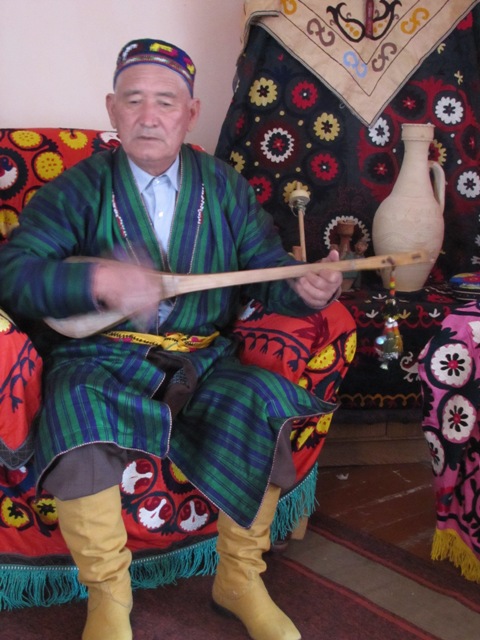
Samarkand (or Samarkand-Nurota) school got formed based on Bulunghur and Kurgan schools, the bright representatives of which were Fozil Yoldosh oghli, Ergash Jumanbulbul oghli, Pulkan shoir, Islom shoir, Abdulla shoir, Ziyadullo Islomov and others.
Kashkadarya school (centers located in Shakhrisabz, Kitab, Qamashi, Chiroqchi, Guzar, Dekhqonobod) is famous with its traditions and bearers as well. Its characteristic features are recitative-declamatory manner of singing with a special guttural voice (boghiq ovoz) and use of short tunes (naghma) in accompaniment of dombra. The prominent representatives of this school are Abdulla Nurali oghli and Islom Nazar oghli, whose students (Qodir bakhshi Rakhimov and his sons – Abduqahhor, Adbumomin, and Bakhrom; Shomurod Toghaev, and others) continue to develop traditions.
Surkhandarya school (centers located in Sherobod, Boysun, Qiziriq, Qumqorgon, Denau, Shorchi) or Sherobod-Boysun school is associated with the name of prominent bakhshi, who is representative of this school, Shernazar Beknazar oghli (or Sherna bakhshi). The manner of performance is recitative-declamatory one with use of special guttural singing technique (boghiq ovoz) accompanied by dombra. From among famous bearers of epic traditions of this particular school it is possible to mention Shoberdi Botaev, Abdunazar Poyonov, Boboraim Mamatmurodov, Qora bakhshi Umirov and others.
Dostons of Khoresm differ with their expressiveness, with their musical and poetical emotionality, which attract listeners. In Khoresm became widespread songful types of dostons (ichki ovoz), in which songs in such genres as terma, qoshuq and ashula became the dominant ones. Khoresm school of epic narrators can be divided into two leading schools: Northern school, or so called "Ironi" school (or Manghit; it is to be found in present-day territory of Khoresm, Karakalpakstan and Dashauz region of Turkmenistan) and Southern school or Khiva school (or so called "Shirvani" school). What makes different the both schools is the repertoire and composition of musicians. Narrators of "Ironi" school accompany their dostons by playing on dutar and ghidjak (they use traditional, three-stringed ghidjak; dutar and doira is used rarely). In "Shirvani" school, narration was accompanied by dutar, bolaman and ghidjak in the past. However, since XX century the musical instruments used include tor, qoshnay (or bolaman) and doira. Leading representatives of the "Ironi" school are Khudoybergan Utegenov, Tengel Kamolov and his students (apprentices). Leading representatives of "Shirvani" school are Bola bakhshi (Qurbonnazar) Abdullaev and his sons (Norbek, Muhammad, Yetmishbay), Qalandar bakhshi Normetov.
In Khoresm, along with male dostonchis, popular are female narrators (called "khalfa-dostonchi"), who sung exclusively among women in the past. In their repertoire dominant place was given to the dostons of romantic character (for instance, "Tokhir and Zukhra"). Singing of dostons is accompanied by an instrumental ensemble, which uses such musical instruments as qol soz (Russian diatonic harmonica) and doira. Performances of khalfa-dostonchi differ with their softness, heartiness and lyricism (Ojiza khalfa).
Folk epic art of Karakalpakstan, which is subdivided into baksy and jyrau arts respectively, also stands out with its own peculiarities and performance manners. Their dostons (folk epics) have ancient roots and enjoy great popularity. For baksy art typical is recitative-songful manner of performance, which is accompanied by playing on dutar or gidjak (which is a traditional one, i.e. three-stringed one). The style of singing is ichki ovoz, which combines the traditions of Khoresm epic and Kazakh aytys. The art of baksy is especially popular among young people, specifically, among young women. Women-baksys, who accompany their singing by playing on dutar, are more emotional. Their singing is of elevated character. From among baksys of Karakalpakstan it is possible to mention Qayratdin Utemurodov, Uralboy Utambetov, Tengelbay Kallyev, Ziyoda Sharipova, Gulbahor Rametova, Gulnur Khamitova and Zamira Ibragimova.
The art of jyrau has ancient roots as well. The manner of performance is recitative-declamatory one, which is combined with guttural singing style. The singing is accompanied by playing on qobuz (stringed instrument; until present it is created based on ancient traditions). Jyraus have been the keepers and disseminators of epic poems and stories (dostons) for many centuries. From among famous jyraus it is possible to mention Jumabay jyrau, Bekbergen Syrymbetov, Jonibek Piyazov, Bakhtiyor Yesemuratov and others.
In general, folk epic of Uzbekistan testifies to high artistic talent of people, from among whom folk narrators (i.e. bakhshi-shoirs and dostonchis), creators and keepers of national epic traditions emerged. Many of them kept in their memory and popularized from 20 to 100 dostons. From among such people it is possible to mention narrators of the XX century such as Pulkan shoir (who knew more than 76 dostons), Qodir bakhshi Rahimov (who knew 72 dostons), Fozil Yoldosh oghli (who knew 60 dostons), Ergash Jumanbulbul oghli (50 dostons), Mardonaqul Avliyoqul oghli (43 dostons), Bola bakhshi Abdullaev (more than 20 dostons), Yusuf Otagan oghli (more than 31 dostons, etc).
The art of bakhshi has been enjoying great popularity to present days. Bright evidence for this is invitation of folk narrators (bakhshis, baksys, jyraus) to family occasions and folk festivities. The Government of Uzbekistan, for its part, highly values the creative activity of folk narrators. As such, it has been awarding many folk narrators with honorable title of "People's bakhshi of Uzbekistan". And from those, who were awarded with this honorable title, it is possible to mention Bola bakhshi Abdullaev and his sons, Norbek Abdullaev (Abdulla Qurbonnazarov) and Yetmishbay Abdullaev, Qalandar bakhshi Normatov (from Khoresm); Shomurot Togaev and Abduqahhor Rakhimov (from Kashkadarya); Ziyodulla Islomov (from Samarkand); Shoberdi Boltaev, Abdunazar Poyonov, Boboraim Mamatmurodov and Qora bakhshi Umirov (from Surkhandarya); Jumaboy jyrau (from Karakalpakstan). At the same time young narrators receive "Nihol" awards. From among such young people it is possible to mention Feruz Normatov, Janibek Piyazov, and others.
In general, the traditions associated with epic have always been transmitted from master to apprentice, from father to son. And bright evidences for succession, continuation and development of epic traditions became organization of traditional competitions of bakhshi-shoirs, which have been conducted in Uzbekistan since 1975 (the last one was organized in the city of Parkent, Tashkent region, in 2013), competitions of young narrators (organized in the city of Kitab, Kashkadarya region). In addition, the art of bakhshi is being mastered nowadays by young performers at different colleges of art (in Karshi, Termez, Urgench and Nukus) and pedagogical universities of the country.





